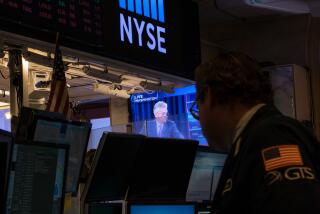Investors Can Cash In on High Interest Rates if They Read the Signs
- Share via
OK, so you’ve locked in a comfy 9% on a six-month certificate of deposit. Or you’ve just bought that three-month Treasury bill paying a nice 9.25%. Or you’ve been lucky enough to pick a money market mutual fund earning a sweet 10%.
You’re in savers’ heaven. But should you try to go “long” and earn even more money?
That is the question that many investors should be beginning to ask, now that rates on CDs, Treasury issues, money market funds and other short-term fixed-income investments have reached their highest levels in years.
Rates on some of these may still go higher. CD rates, for example, may rise further in April, as savings institutions compete for billions of dollars in CDs expected to mature this month. April traditionally is the heaviest month for CD maturities and new purchases, in part because people need cash for tax payments or deposit their tax refunds.
But if and when interest rates in the economy peak and begin to fall--an event that some analysts say may be just around the corner--you could earn a lot more by buying savings-oriented investments with longer maturities, such as mutual funds investing in long-term bonds. When interest rates fall, these longer-term vehicles gain in value, on top of paying interest.
That’s because investors will be willing to pay more for already issued investments that lock in higher interest rates than are available for new investments. A 30-year Treasury bond, for example, can gain as much as 10% in value for each 1 percentage point drop in interest rates.
Investors in long-term bonds and bond mutual funds made as much as 30% to 40% in 1982, when banks’ prime lending rate dropped five percentage points. In a recession, when business activity slows and interest rates tumble, long-term bonds can be among the best investments around.
Of course, the opposite is true if interest rates rise. When interest rates jump by one point, you can lose as much as 10% in long-term bonds. Investors learned this lesson painfully in 1987 and again recently when rates rose sharply.
That is why it is important to wait until interest rates peak before you jump into longer-term fixed-income investments.
How do you know that interest rates have peaked?
Perhaps the surest and safest sign is to look for a drop in the prime rate, which now stands at 11.5% and has been rising steadily in recent months. Banks typically don’t drop the prime until they are convinced that other interest rates are heading south. Thus, the prime lags other falling rates--but is more reliable.
“It’s better to be a little late,” Donald J. Phillips, editor Mutual Fund Values, a Chicago-based investment advisory service. “You can still catch plenty of the effect of lower rates even if you’re not the first one on the bandwagon.”
A much quicker, but somewhat less reliable, sign is a decline in the so-called federal funds rate. That is what banks pay on reserves for overnight use. That rate, currently around 9.8%, will begin to move down if the Federal Reserve Board decides it is time to ease credit conditions and drive down other rates.
Another quick sign will be falling investment yields on Treasury bills. You can also look for rates on CDs or money market funds.
Another sign that interest rates may be beginning to peak is a sustained fall in the inflation rate. The Fed has been raising rates in order to fight rising inflation.
A small but growing number of analysts think an interest rate peak may be near or already has happened. They cite evidence that inflation may not be as bad as previously feared and that economic growth may be slowing. Both indicators would cause the Fed to ease interest rates.
Some forecasters are going even further. The UCLA Business Forecasting Project, for example, on Thursday predicted a national recession starting in the third quarter.
But they and other economists have cried wolf before. So conservative investors should wait until the evidence is more persuasive.
Once you are convinced that rates are falling, where should you invest? Here are several options appropriate for small investors:
- Long-term bond mutual funds. This is probably the easiest and most convenient way to play. And if you buy “no-load” funds that don’t charge sales commissions, it is also the cheapest. And if you decide you’ve made a mistake and want to pull out, selling fund shares is relatively painless.
Phillips of Mutual Fund Values suggests sticking to funds with high-quality issues, being wary of popular high-yield bond funds that invest in riskier “junk bonds.” They yield more and can also gain in value if rates fall, but if the economy enters into a recession, more junk bonds will default, reducing returns.
One high-quality long-term bond fund that Phillips recommends is Vanguard Fixed Income-U.S. Treasury Bond Fund (800-662-7447), which invests primarily in Treasury issues.
If you’re interested in the safety of government bonds but want more potential returns, Phillips suggests Benham Target Maturity 2005 (800-982-6150 in California), a fund that invests in long-term zero-coupon Treasury bonds. They rise dramatically when interest rates fall.
Another sometimes mentioned alternative is Ginnie Mae funds, which invest in packages of home mortgages. However, investors often cannot enjoy the full fruits of declining interest rates because as mortgage rates fall, homeowners refinance at lower rates, reducing yields on Ginnie Maes.
- Intermediate-term bond funds. As a less volatile compromise, consider buying these funds, with maturities generally between two and 10 years. While you won’t earn as much price appreciation if interest rates fall, you won’t lose as much if you guess wrong and rates head back up.
By investing in intermediate maturities, “you can get most of the returns (of long-term bonds) without taking all of the risks,” says Steve Janachowski of Brouwer & Janachowski, a San Francisco money management firm.
Also, Janachowski says, the bond market “is harder to time than the stock market, because it can turn around overnight. (Fed Chairman Alan) Greenspan could wake up one morning and be paranoid about inflation and put his foot on the brakes.”
Intermediate-term bond funds that Janachowski likes include Fidelity Intermediate Bond Fund (800-544-6666), with maturities of around 10 years, and Neuberger & Berman Limited Maturity Bond Fund (800-367-0770), a conservative alternative with maturities of two to five years.
Fund analyst Phillips also suggests Boston Co. Managed Income (800-225-5267) and Babson Bond Trust (800-422-2766). And he suggests Strong Income Fund (800-368-3863), whose managers try to time the bond market by shifting maturities, going shorter when rates rise and longer when rates fall.
- Long- or intermediate-term Treasuries. Treasury bonds, with maturities of between 10 and 30 years, are easy to buy and sell, requiring minimum investments of as little as $1,000. And they are safe. Your principal, if you hold a Treasury bond to maturity, is backed by the full faith and credit of the U.S. government.
As a less volatile compromise, consider buying medium-term Treasury notes, with maturities of between two and 10 years.
- Long- or intermediate-term municipal bonds. These are good if you’re in a high tax bracket, since interest won’t be subject to federal taxes and possibly state and local as well. Most small investors are better off in mutual funds or unit investment trusts rather than individual issues.
Investment adviser Janachowski likes Fidelity Limited Term Municipal (800-544-6666), Vanguard Municipal Bond Fund--Intermediate Term (800-662-7447) as well as Stein Roe Tax-Exempt Income Trust--Managed Municipals (800-338-2550).
- Long-term brokered CDs. These are conventional CDs issued by banks or savings and loans that are traded actively at stock brokerages just like bonds. Accordingly, like bonds, they rise and fall in value if sold before maturity, and you don’t have to pay early withdrawal penalties. But they are still insured by federal deposit insurance agencies.
Bill Sing welcomes readers’ comments and suggestions for columns but regrets that he cannot respond individually to letters. Write to Bill Sing, Personal Finance, Los Angeles Times, Times Mirror Square, Los Angeles, Calif. 90053.
More to Read
Inside the business of entertainment
The Wide Shot brings you news, analysis and insights on everything from streaming wars to production — and what it all means for the future.
You may occasionally receive promotional content from the Los Angeles Times.










